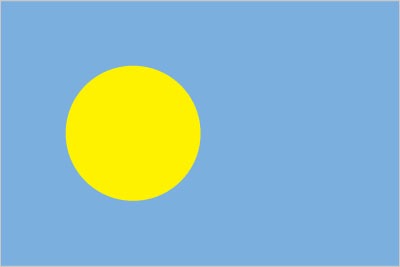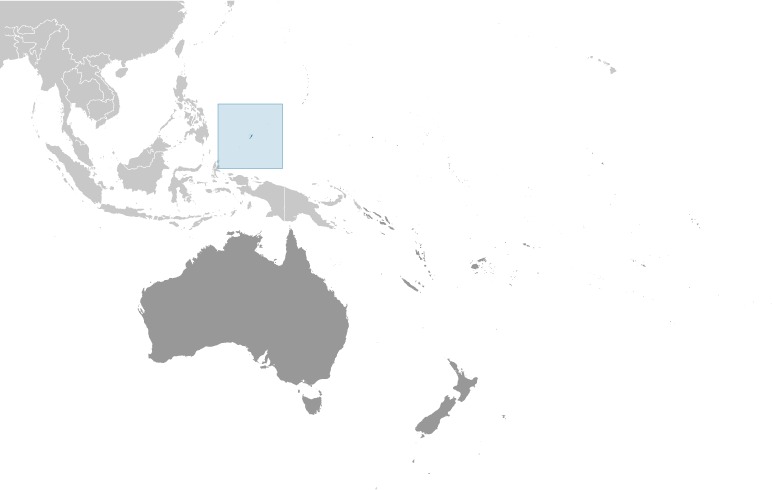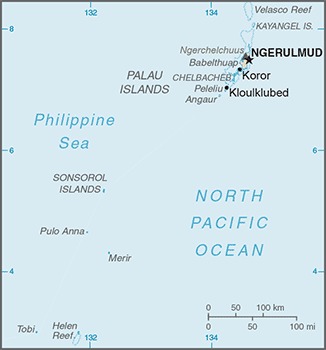


-
Introduction :: Palau
-
Background:After three decades as part of the UN Trust Territory of the Pacific under US administration, this westernmost cluster of the Caroline Islands opted for independence in 1978 rather than join the Federated States of Micronesia. A Compact of Free Association with the US was approved in 1986 but not ratified until 1993. It entered into force the following year when the islands gained independence.
-
Geography :: Palau
-
Location:Oceania, group of islands in the North Pacific Ocean, southeast of the PhilippinesGeographic coordinates:7 30 N, 134 30 EMap references:OceaniaArea:total: 459 sq kmland: 459 sq kmwater: 0 sq kmcountry comparison to the world: 197Area - comparative:slightly more than 2.5 times the size of Washington, DCArea comparison map:
 The World Factbook Field Image ModalAustralia - Oceania :: Palau Print
The World Factbook Field Image ModalAustralia - Oceania :: Palau Print Image Description
Image Descriptionslightly more than 2.5 times the size of Washington, DC
Land boundaries:0 kmCoastline:1,519 kmMaritime claims:territorial sea: 12 nmexclusive economic zone: 200 nmcontiguous zone: 24 nmcontinental shelf: 200 nmClimate:tropical; hot and humid; wet season May to NovemberTerrain:varying topography from the high, mountainous main island of Babelthuap to low, coral islands usually fringed by large barrier reefsElevation:lowest point: Pacific Ocean 0 mhighest point: Mount Ngerchelchuus 242 mNatural resources:forests, minerals (especially gold), marine products, deep-seabed mineralsLand use:agricultural land: 10.8% (2011 est.)arable land: 2.2% (2011 est.) / permanent crops: 4.3% (2011 est.) / permanent pasture: 4.3% (2011 est.)forest: 87.6% (2011 est.)other: 1.6% (2011 est.)Irrigated land:0 sq km (2012)Population distribution:most of the population is located on the southern end of the main island of BabelthuapNatural hazards:typhoons (June to December)Environment - current issues:inadequate facilities for disposal of solid waste; threats to the marine ecosystem from sand and coral dredging, illegal and destructive fishing practices, and overfishing; climate change contributes to rising sea level and coral bleaching; droughtEnvironment - international agreements:party to: Biodiversity, Climate Change, Climate Change-Kyoto Protocol, Desertification, Hazardous Wastes, Law of the Sea, Ozone Layer Protection, Wetlands, Whalingsigned, but not ratified: none of the selected agreementsGeography - note:westernmost archipelago in the Caroline chain, consists of six island groups totaling more than 300 islands; includes World War II battleground of Beliliou (Peleliu) and world-famous Rock Islands -
People and Society :: Palau
-
Population:21,685 (July 2020 est.)country comparison to the world: 218Nationality:noun: Palauan(s)adjective: PalauanEthnic groups:Palauan (Micronesian with Malayan and Melanesian admixtures) 73%, Carolinian 2%, Asian 21.7%, caucasian 1.2%, other 2.1% (2015 est.)Languages:Palauan (official on most islands) 65.2%, other Micronesian 1.9%, English (official) 19.1%, Filipino 9.9%, Chinese 1.2%, other 2.8% (2015 est.)
note: Sonsoralese is official in Sonsoral; Tobian is official in Tobi; Angaur and Japanese are official in Angaur
Religions:Roman Catholic 45.3%, Protestant 34.9% (includes Evangelical 26.4%, Seventh Day Adventist 6.9%, Assembly of God .9%, Baptist .7%), Modekngei 5.7% (indigenous to Palau), Muslim 3%, Mormon 1.5%, other 9.7% (2015 est.)Age structure:0-14 years: 18.68% (male 2,090/female 1,961)15-24 years: 15.86% (male 1,723/female 1,716)25-54 years: 45.33% (male 6,026/female 3,804)55-64 years: 10.68% (male 853/female 1,463)65 years and over: 9.45% (male 501/female 1,548) (2020 est.)population pyramid:The World Factbook Field Image ModalAustralia - Oceania :: Palau PrintImage DescriptionThis is the population pyramid for Palau. A population pyramid illustrates the age and sex structure of a country's population and may provide insights about political and social stability, as well as economic development. The population is distributed along the horizontal axis, with males shown on the left and females on the right. The male and female populations are broken down into 5-year age groups represented as horizontal bars along the vertical axis, with the youngest age groups at the bottom and the oldest at the top. The shape of the population pyramid gradually evolves over time based on fertility, mortality, and international migration trends.
For additional information, please see the entry for Population pyramid on the Definitions and Notes page under the References tab.Median age:total: 33.9 yearsmale: 32.9 yearsfemale: 35.9 years (2020 est.)country comparison to the world: 94Population growth rate:0.39% (2020 est.)country comparison to the world: 162Birth rate:11.3 births/1,000 population (2020 est.)country comparison to the world: 173Death rate:8.3 deaths/1,000 population (2020 est.)country comparison to the world: 80Net migration rate:0.9 migrant(s)/1,000 population (2020 est.)country comparison to the world: 61Population distribution:most of the population is located on the southern end of the main island of BabelthuapUrbanization:urban population: 81% of total population (2020)rate of urbanization: 1.77% annual rate of change (2015-20 est.)Major urban areas - population:277 NGERULMUD (capital) (2018)Sex ratio:at birth: 1.07 male(s)/female0-14 years: 1.07 male(s)/female15-24 years: 1 male(s)/female25-54 years: 1.58 male(s)/female55-64 years: 0.58 male(s)/female65 years and over: 0.32 male(s)/femaletotal population: 1.07 male(s)/female (2020 est.)Infant mortality rate:total: 9.8 deaths/1,000 live birthsmale: 11.2 deaths/1,000 live birthsfemale: 8.3 deaths/1,000 live births (2020 est.)country comparison to the world: 132Life expectancy at birth:total population: 74.1 yearsmale: 70.9 yearsfemale: 77.5 years (2020 est.)country comparison to the world: 136Total fertility rate:1.7 children born/woman (2020 est.)country comparison to the world: 172Drinking water source:improved: urban: 100% of populationrural: 100% of populationtotal: 100% of populationunimproved: urban: 0% of populationrural: 0% of populationtotal: 0% of population (2017 est.)Current Health Expenditure:12% (2017)Physicians density:1.42 physicians/1,000 population (2014)Hospital bed density:4.8 beds/1,000 population (2010)Sanitation facility access:improved: urban: 100% of populationrural: 100% of populationtotal: 100% of populationunimproved: urban: 0% of populationrural: 0% of populationtotal: 0% of population (2017 est.)HIV/AIDS - adult prevalence rate:NAHIV/AIDS - people living with HIV/AIDS:NAHIV/AIDS - deaths:NAMajor infectious diseases:degree of risk: high (2020)food or waterborne diseases: bacterial diarrheavectorborne diseases: malariaObesity - adult prevalence rate:55.3% (2016)country comparison to the world: 3Education expenditures:NALiteracy:definition: age 15 and over can read and writetotal population: 96.6%male: 96.8%female: 96.3% (2015)School life expectancy (primary to tertiary education):total: 17 yearsmale: 16 yearsfemale: 17 years (2013)Unemployment, youth ages 15-24:5.6%country comparison to the world: 162 -
Government :: Palau
-
Country name:conventional long form: Republic of Palauconventional short form: Palaulocal long form: Beluu er a Belaulocal short form: Belauformer: Trust Territory of the Pacific Islands, Palau Districtetymology: from the Palauan name for the islands, Belau, which likely derives from the Palauan word "beluu" meaning "village"Government type:presidential republic in free association with the USCapital:name: Ngerulmudgeographic coordinates: 7 30 N, 134 37 Etime difference: UTC+9 (14 hours ahead of Washington, DC, during Standard Time)etymology: the Palauan meaning is "place of fermented 'mud'" ('mud' being the native name for the keyhole angelfish); the site of the new capitol (established in 2006) had been a large hill overlooking the ocean, Ngerulmud, on which women would communally gather to offer fermented angelfish to the gods
note: Ngerulmud, on Babeldaob Island, is the smallest national capital on earth by population, with only a few hundred people; the name is pronounced en-jer-al-mud; Koror, on Koror Island, with over 11,000 residents is by far the largest settlement in Palau; it served as the country's capital from independence in 1994 to 2006Administrative divisions:16 states; Aimeliik, Airai, Angaur, Hatohobei, Kayangel, Koror, Melekeok, Ngaraard, Ngarchelong, Ngardmau, Ngatpang, Ngchesar, Ngeremlengui, Ngiwal, Peleliu, SonsorolIndependence:1 October 1994 (from the US-administered UN trusteeship)National holiday:Constitution Day, 9 July (1981), day of a national referendum to pass the new constitution; Independence Day, 1 October (1994)Constitution:history: ratified 9 July 1980, effective 1 January 1981amendments: proposed by a constitutional convention (held at least once every 15 years with voter approval), by public petition of at least 25% of eligible voters, or by a resolution adopted by at least three fourths of National Congress members; passage requires approval by a majority of votes in at least three fourths of the states in the next regular general election; amended 1992, 2004, 2008Legal system:mixed legal system of civil, common, and customary lawInternational law organization participation:has not submitted an ICJ jurisdiction declaration; non-party state to the ICCtCitizenship:citizenship by birth: nocitizenship by descent only: at least one parent must be a citizen of Palaudual citizenship recognized: noresidency requirement for naturalization: note - no procedure for naturalizationSuffrage:18 years of age; universalExecutive branch:chief of state: President Tommy REMENGESAU (since 17 January 2013); Vice President Raynold OILUCH (since 19 January 2017); note - the president is both chief of state and head of governmenthead of government: President Tommy REMENGESAU (since 17 January 2013); Vice President Raynold OILUCH (since 19 January 2017)cabinet: Cabinet appointed by the president with the advice and consent of the Senate; also includes the vice president; the Council of Chiefs consists of chiefs from each of the states who advise the president on issues concerning traditional laws, customs, and their relationship to the constitution and laws of Palauelections/appointments: president and vice president directly elected on separate ballots by absolute majority popular vote in 2 rounds if needed for a 4-year term (eligible for a second term); election last held on 3 November 2020 (next to be held on November 2024)election results: Surangel WHIPPS, Jr. elected president; percent of vote - Surangel WHIPPS, Jr.(independent) 57.4%, Raynold OILUCH (independent) 42.6%Legislative branch:description: bicameral National Congress or Olbiil Era Kelulau consists of:
Senate (13 seats; members directly elected in single-seat constituencies by majority vote to serve 4-year terms)
House of Delegates (16 seats; members directly elected in single-seat constituencies by simple majority vote to serve 4-year terms)elections:
Senate - last held on 1 November 2016 (next to be held on 3 November 2020)
House of Delegates - last held on 1 November 2016 (next to be held on 3 November 2020)election results:
Senate - percent of vote - NA; seats - independent 13; composition - men 11, women 2, percent of women 15.4%
House of Delegates - percent of vote - NA; seats - independent 16; composition - men 14, women 2, percent of women 12.5%; note - total National Congress percent of women 13.8%Judicial branch:highest courts: Supreme Court (consists of the chief justice and 3 associate justices organized into appellate trial divisions; the Supreme Court organization also includes the Common Pleas and Land Courts)judge selection and term of office: justices nominated by a 7-member independent body consisting of judges, presidential appointees, and lawyers and appointed by the president; judges can serve until mandatory retirement at age 65subordinate courts: National Court and other 'inferior' courtsPolitical parties and leaders:noneInternational organization participation:ACP, ADB, AOSIS, FAO, IAEA, IBRD, ICAO, ICRM, IDA, IFC, IFRCS, ILO, IMF, IMO, IMSO, IOC, IPU, MIGA, OPCW, PIF, Sparteca, SPC, UN, UNAMID, UNCTAD, UNESCO, WHODiplomatic representation in the US:chief of mission: Ambassador Hersey KYOTA (since 12 November 1997)chancery: 1701 Pennsylvania Avenue NW, Suite 300, Washington, DC 20036telephone: [1] (202) 452-6814FAX: [1] (202) 452-6281consulate(s): Tamuning (Guam)Diplomatic representation from the US:chief of mission: Ambassador Amy HYATT (since 9 March 2015)telephone: [680] 587-2920embassy: Omsangel/Beklelachieb, Airai 96940mailing address: P. O. Box 6028, Koror, Republic of Palau 96940FAX: [680] 587-2911Flag description:light blue with a large yellow disk shifted slightly to the hoist side; the blue color represents the ocean, the disk represents the moon; Palauans consider the full moon to be the optimum time for human activity; it is also considered a symbol of peace, love, and tranquilityNational symbol(s):bai (native meeting house); national colors: blue, yellowNational anthem:name: "Belau rekid" (Our Palau)lyrics/music: multiple/Ymesei O. EZEKIELnote: adopted 1980
-
Economy :: Palau
-
Economic overview:
The economy is dominated by tourism, fishing, and subsistence agriculture. Government is a major employer of the work force relying on financial assistance from the US under the Compact of Free Association (Compact) with the US that took effect after the end of the UN trusteeship on 1 October 1994. The US provided Palau with roughly $700 million in aid for the first 15 years following commencement of the Compact in 1994 in return for unrestricted access to its land and waterways for strategic purposes. The population enjoys a per capita income roughly double that of the Philippines and much of Micronesia.
Business and leisure tourist arrivals reached a record 167,966 in 2015, a 14.4% increase over the previous year, but fell to 138,408 in 2016. Long-run prospects for tourism have been bolstered by the expansion of air travel in the Pacific, the rising prosperity of industrial East Asia, and the willingness of foreigners to finance infrastructure development. Proximity to Guam, the region's major destination for tourists from East Asia, and a regionally competitive tourist infrastructure enhance Palau's advantage as a destination.
GDP real growth rate:-3.7% (2017 est.)0% (2016 est.)10.1% (2015 est.)country comparison to the world: 215Inflation rate (consumer prices):0.9% (2017 est.)-1% (2016 est.)country comparison to the world: 61GDP (purchasing power parity) - real:$264 million (2017 est.)$274.2 million (2016 est.)$274.1 million (2015 est.)note: data are in 2017 dollars
GDP (official exchange rate):$292 million (2017 est.)GDP - per capita (PPP):$14,700 (2017 est.)$15,200 (2016 est.)$15,200 (2015 est.)note: data are in 2017 dollars
country comparison to the world: 97Gross national saving:48.7% of GDP (2016 est.)50.1% of GDP (2015 est.)country comparison to the world: 2GDP - composition, by sector of origin:agriculture: 3% (2016 est.)industry: 19% (2016 est.)services: 78% (2016 est.)GDP - composition, by end use:household consumption: 60.5% (2016 est.)government consumption: 27.2% (2016 est.)investment in fixed capital: 22.7% (2016 est.)investment in inventories: 1.9% (2016 est.)exports of goods and services: 55.2% (2016 est.)imports of goods and services: -67.6% (2016 est.)Ease of Doing Business Index scores:82.1 (2020)Agriculture - products:coconuts, cassava (manioc, tapioca), sweet potatoes; fish, pigs, chickens, eggs, bananas, papaya, breadfruit, calamansi, soursop, Polynesian chestnuts, Polynesian almonds, mangoes, taro, guava, beans, cucumbers, squash/pumpkins (various), eggplant, green onions, kangkong (watercress), cabbages (various), radishes, betel nuts, melons, peppers, noni, okraIndustries:tourism, fishing, subsistence agricultureIndustrial production growth rate:NALabor force:11,610 (2016)country comparison to the world: 215Labor force - by occupation:agriculture: 1.2%industry: 12.4%services: 86.4% (2016)Unemployment rate:1.7% (2015 est.)4.1% (2012)country comparison to the world: 16Population below poverty line:24.9% NA (2006)Household income or consumption by percentage share:lowest 10%: NAhighest 10%: NABudget:revenues: 193 million (2012 est.)expenditures: 167.3 million (2012 est.)Taxes and other revenues:66.1% (of GDP) (2016 est.)country comparison to the world: 6Budget surplus (+) or deficit (-):8.8% (of GDP) (2016 est.)country comparison to the world: 3Public debt:24.1% of GDP (2016 est.)21.6% of GDP (2015)country comparison to the world: 179Fiscal year:1 October - 30 SeptemberCurrent account balance:-$53 million (2017 est.)-$36 million (2016 est.)country comparison to the world: 80Exports:$23.17 billion (2017 est.)$14.8 million (2015 est.)country comparison to the world: 76Exports - partners:Japan 51.3%, US 15.8%, India 13.8%, Guam 8% (2017)Exports - commodities:shellfish, tuna, other fish (many species)Imports:$4.715 billion (2018 est.)$4.079 billion (2017 est.)country comparison to the world: 142Imports - commodities:machinery and equipment, fuels, metals; foodstuffsImports - partners:US 33.4%, Guam 15.8%, Japan 15.7%, China 13.5%, South Korea 5.3% (2017)Reserves of foreign exchange and gold:$0 (31 December 2017 est.)$580.9 million (31 December 2015 est.)country comparison to the world: 193Debt - external:$18.38 billion (31 December 2014 est.)$16.47 billion (31 December 2013 est.)country comparison to the world: 94Exchange rates:the US dollar is used
-
Energy :: Palau
-
Electricity access:electrification - total population: 100% (2018)
-
Communications :: Palau
-
Telephones - fixed lines:total subscriptions: 8,808subscriptions per 100 inhabitants: 40.78 (2019 est.)country comparison to the world: 191Telephones - mobile cellular:total subscriptions: 29,033subscriptions per 100 inhabitants: 134.41 (2019 est.)country comparison to the world: 210Telecommunication systems:general assessment: well-developed mobile sector, recently boosted by satellite network capacity upgrades; 3G services available with satellite; lack of telecom regulations; newest and most powerful commercial satellite, Kacific-1 satellite, launched in 2019 to improve telecommunications in the Asia Pacific region (2020)domestic: fixed-line 41 per 100 and mobile-cellular services 134 per 100 persons (2019)international: country code - 680; landing point for the SEA-US submarine cable linking Palau, Philippines, Micronesia, Indonesia, Hawaii (US), Guam (US) and California (US); satellite earth station - 1 Intelsat (Pacific Ocean) (2019)note: the COVID-19 outbreak is negatively impacting telecommunications production and supply chains globally; consumer spending on telecom devices and services has also slowed due to the pandemic's effect on economies worldwide; overall progress towards improvements in all facets of the telecom industry - mobile, fixed-line, broadband, submarine cable and satellite - has moderatedBroadcast media:no broadcast TV stations; a cable TV network covers the major islands and provides access to 4 local cable stations, rebroadcasts (on a delayed basis) of a number of US stations, as well as access to a number of real-time satellite TV channels; about a half dozen radio stations (1 government-owned) (2019)Internet country code:.pwInternet users:total: 7,650percent of population: 36% (July 2016 est.)country comparison to the world: 214
-
Transportation :: Palau
-
National air transport system:number of registered air carriers: 1 (2020)inventory of registered aircraft operated by air carriers: 1Airports:3 (2013)country comparison to the world: 195Airports - with paved runways:total: 1 (2019)1,524 to 2,437 m: 1Airports - with unpaved runways:total: 2 (2013)1,524 to 2,437 m: 2 (2013)Roadways:total: 125 km (2018)paved: 89 km (2018)unpaved: 36 km (2018)country comparison to the world: 211Merchant marine:total: 203by type: bulk carrier 9, container ship 11, general cargo 88, oil tanker 31, other 64 (2019)country comparison to the world: 66Ports and terminals:major seaport(s): Koror
-
Military and Security :: Palau
-
Military and security forces:no regular military forces; the Ministry of Justice includes divisions/bureaus for public security, police functions, and maritime law enforcement. (2019)Military equipment inventories and acquisitions:since 2018, Australia and Japan have provided patrol boats to the Palau's Division of Marine Law Enforcement (2020)Military - note:Under a 1994 Compact of Free Association between Palau and the US, the US until 2044 is responsible for the defense of Palaus and the US military is granted access to the islands, but it has not stationed any military forces there. (2020)
-
Transnational Issues :: Palau
-
Disputes - international:
maritime delineation negotiations continue with Philippines, Indonesia


